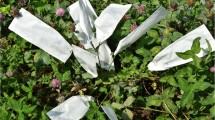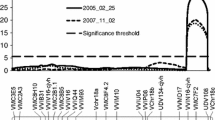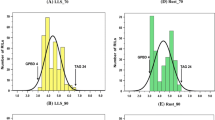Abstract
Podosphaera pannosa, the causal agent of rose powdery mildew, hampers the production of cut roses throughout the world. A major tool to control this disease is the use of resistant plant material. Single resistance genes, like Rpp1, may be overcome within a few years by high risk pathogens like powdery mildews. Durable resistance could be achieved using quantitative resistances. Here we describe mapping of QTLs for resistance to P. pannosa in six different environments (artificial and natural infections in the greenhouse over 3 years and natural infections in the field over 2 years). AFLPs, RGAs and other marker types were used to construct an integrated linkage map for the diploid population 97/7 containing 233 markers. In a selective genotyping procedure, marker segregation was analysed for 170 of the up to 270 phenotyped individuals. We identified seven linkage groups with an average length of 60 cM, corresponding to seven rose chromosomes in the haploid set. Using an LOD significance threshold of 3.9 we detected a total of 28 QTLs for the nine powdery mildew disease scores under analysis. Using the data from artificial inoculations with powdery mildew race 9, three resistance QTLs explaining about 84% of the variability were mapped. Twelve and 15 QTLs were detected for resistance to naturally occurring infections in the greenhouse and in the field, respectively, over several years.




Similar content being viewed by others
References
Aarts MGM, Hekkert BT, Holub EB, Beynon JL, Stiekema WJ, Pereira A (1998) Identification of R-gene homologous DNA fragments genetically linked to disease resistance loci in Arabidopsis thaliana. Mol Plant Microbe Interact 11:251–258
Ayoub M, Mather DE (2002) Effectiveness of selective genotyping for detection of quantitative trait loci: an analysis of grain and malt quality traits in three barley populations. Genome 45:1116–1124
Backes G, Madsen LH, Jaiser H, Stougaard J, Herz M, Mohler V, Jahoor A (2003) Localisation of genes for resistance against Blumeria graminis f.sp hordei and Puccinia graminis in a cross between a barley cultivar and a wild barley (Hordeum vulgare ssp. spontaneum) line. Theor Appl Genet 106:353–362
Baker B, Zambryski P, Staskawicz B, DineshKumar SP (1997) Signaling in plant–microbe interactions. Science 276:726–733
Bubeck DM, Goodman MM, Beavis WD, Grant D (1993) Quantitative trait loci controlling resistance to gray leaf-spot in maize. Crop Sci 33:838–847
Crespel L, Chirollet M, Durel CE, Zhang D, Meynet J, Gudin S (2002) Mapping of qualitative and quantitative phenotypic traits in Rosa using AFLP markers. Theor Appl Genet 105:1207–1214
Dangl JL, Jones JDG (2001) Plant pathogens and integrated defence responses to infection. Nature 411:826–833
Darvasi A, Soller M (1992) Selective genotyping for determination of linkage between a marker locus and a quantitative trait locus. Theor Appl Genet 85:353–359
Darvasi A, Weinreb A, Minke V, Weller JI, Soller M (1993) Detecting marker-QTL linkage and estimating QTL gene effect and map location using a saturated genetic-map. Genetics 134:943–951
Debener T, Mattiesch L (1999) Construction of a genetic linkage map for roses using RAPD and AFLP markers. Theor Appl Genet 99:891–899
Debener T, Mattiesch L, Vosman B (2001) A molecular marker map for roses. Acta Hortic 547:283–287
Dugo ML, Satovic Z, Millan T, Cubero JI, Rubiales D, Cabrera A, Torres AM (2005) Genetic mapping of QTLs controlling horticultural traits in diploid roses. Theor Appl Genet 111:511–520
Frye CA, Tang DZ, Innes RW (2001) Negative regulation of defense responses in plants by a conserved MAPKK kinase. Proc Natl Acad Sci USA 98:373–378
Gudin S (2000) Rose: genetics and breeding. Plant Breed Rev 17:59–189
Hattendorf A, Debener T (submitted for publication) Molecular characterisation of NBS-LRR-RGAs in the rose genome. Theor Appl Genet
Jansen RC (1993) Interval mapping of multiple quantitative trait loci. Genetics 135:205–211
Jansen RC, Stam P (1994) High-resolution of quantitative traits into multiple loci via interval mapping. Genetics 136:1447-1455
Johnson DL, Jansen RC, Van Arendonk JAM (1999) Mapping quantitative trait loci in a selectively genotyped outbred population using a mixture model approach. Genet Res 73:75–83
Kanazin V, Marek LF, Shoemaker RC (1996) Resistance gene analogs are conserved and clustered in soybean. Proc Natl Acad Sci Biol 93:11746–11750
Kaufmann H, Mattiesch L, Lorz H, Debener T (2003) Construction of a BAC library of Rosa rugosa Thunb. and assembly of a contig spanning Rdr1, a gene that confers resistance to blackspot. Mol Genet Genomics 268:666–674
Kearsey MJ (1998) The principles of QTL analysis (a minimal mathematics approach). J Exp Bot 49:1619–1623
Kearsey MJ, Farquhar AGL (1998) QTL analysis in plants; where are we now? Heredity 80:137–142
Keller M, Keller B, Schachermayr G, Winzeler M, Schmid JE, Stamp P, Messmer MM (1999) Quantitative trait loci for resistance against powdery mildew in a segregating wheat × spelt population. Theor Appl Genet 98:903–912
Keller B, Feuillet C, Yahiaoui N (2005) Map-based isolation of disease resistance genes from bread wheat: cloning in a supersize genome. Genet Res 85:93–100
Kobayashi N, Horikoshi T, Katsuyama H, Handa T, Takayanagi K (1998) A simple and efficient DNA extraction method for plants, especially woody plants. Plant Tissue Cult Biotechnol 4:77–81
Kosambi DD (1944) The estimation of map distance from recombination values. Ann Eugen 12:172–175
Kover PX, Caicedo AL (2001) The genetic architecture of disease resistance in plants and the maintenance of recombination by parasites. Mol Ecol 10:1–16
Lalli DA, Decroocq V, Blenda AV, Schurdi-Levraud V, Garay L, Le Gall O, Damsteegt V, Reighard GL, Abbott AG (2005) Identification and mapping of resistance gene analogs (RGAs) in Prunus: a resistance map for Prunus. Theor Appl Genet 111:1504–1513
Lander ES, Botstein D (1989) Mapping mendelian factors underlying quantitative traits using Rflp linkage maps. Genetics 121:185–199
Leister D (2004) Tandem and segmental gene duplication and recombination in the evolution of plant disease resistance genes. Trends Genet 20:116–122
Linde M, Debener T (2003) Isolation and identification of eight races of powdery mildew of roses (Podosphaera pannosa) (Wallr.:Fr.) de Bary and the genetic analysis of the resistance gene Rpp1. Theor Appl Genet 107:256–262
Linde M, Mattiesch L, Debener T (2004) Rpp1, a dominant gene providing race-specific resistance to rose powdery mildew (Podosphaera pannosa): molecular mapping, SCAR development and confirmation of disease resistance data. Theor Appl Genet 109:1261–1266
Linde M, Yan Z, Debener T (2006) Ornamentals. In: Kole C (ed) Genome mapping and molecular breeding in plants, vol. 6. Technical crops. Springer, Berlin Heidelberg New York (in press)
McCouch SR, Doerge RW (1995) QTL mapping in rice. Trends Genet 11:482–487
McDonald BA, Linde C (2002) The population genetics of plant pathogens and breeding strategies for durable resistance. Euphytica 124:163–180
Meyers BC, Dickerman AW, Michelmore RW, Sivaramakrishnan S, Sobral BW, Young ND (1999) Plant disease resistance genes encode members of an ancient and diverse protein family within the nucleotide-binding superfamily. Plant J 20:317–332
Parlevliet JE (2002) Durability of resistance against fungal, bacterial and viral pathogens; present situation. Euphytica 124:147–156
Rajapakse S, Byrne DH, Zhang L, Anderson N, Arumuganathan K, Ballard RE (2001) Two genetic linkage maps of tetraploid roses. Theor Appl Genet 103:575–583
Ramalingam J, Cruz CMV, Kukreja K, Chittoor JM, Wu JL, Lee SW, Baraoidan M, George ML, Cohen MB, Hulbert SH, Leach JE, Leung H (2003) Candidate defense genes from rice, barley, and maize and their association with qualitative and quantitative resistance in rice. Mol Plant Microbe Interact 16:14–24
Reimann-Philipp R (1981) Cytogenetics and breeding in diploid roses from the triploid hybrid R. multiflora × garden cultivars. In: Eucarpia (ed) Proceedings of Eucarpia Ornamentals Meeting on Rose Breeding. Eucarpia, pp 27–29
Stam P (1993) Construction of integrated genetic-linkage maps by means of a new computer package—Joinmap. Plant J 3:739–744
Von Malek B, Weber WE, Debener T (2000) Identification of molecular markers linked to Rdr1, a gene conferring resistance to blackspot in roses. Theor Appl Genet 101:977–983
Van Ooijen JW (1992) Accuracy of mapping quantitative trait loci in autogamous species. Theor Appl Genet 84:803–811
Van Ooijen (1999) LOD significance thresholds for QTL analysis in experimental populations of diploid species. Heredity 83:613–624
Van Ooijen JW, Voorrips RE (2001) JoinMap 3.0, Software for the calculation of genetic linkage maps. Plant Research International, Wageningen, pp 1–51
Van Ooijen JW, Boer MP, Jansen RC, Maliepaard C (2002) MapQTL 4.0: software for the calculation of QTL positions on genetic maps. Plant Research International, Wageningen
Wilson IW, Schiff CL, Hughes DE, Somerville SC (2001) Quantitative trait loci analysis of powdery mildew disease resistance in the Arabidopsis thaliana accession Kashmir-1. Genetics 158:1301–1309
Xiao SY, Ellwood S, Calis O, Patrick E, Li TX, Coleman M, Turner JG (2001) Broad-spectrum mildew resistance in Arabidopsis thaliana mediated by RPW8. Science 291:118–120
Xu SZ, Vogl C (2000) Maximum likelihood analysis of quantitative trait loci under selective genotyping. Heredity 84:525–537
Yan Z, Denneboom C, Hattendorf A, Dolstra O, Debener T, Stam P, Visser PB (2005) Construction of an integrated map of rose with AFLP, SSR, PK, RGA, RFLP, SCAR and morphological markers. Theor Appl Genet 110:766–777
Young ND (1996) QTL mapping and quantitative disease resistance in plants. Annu Rev Phytopathol 34:479–501
Zhang LP, Lin GY, Nino-Liu D, Foolad MR (2003) Mapping QTLs conferring early blight (Alternaria solani) resistance in a Lycopersicon esculentum × L. hirsutum cross by selective genotyping. Mol Breed 12:3–19
Author information
Authors and Affiliations
Corresponding author
Additional information
Communicated by C. Gebhardt.
Rights and permissions
About this article
Cite this article
Linde, M., Hattendorf, A., Kaufmann, H. et al. Powdery mildew resistance in roses: QTL mapping in different environments using selective genotyping. Theor Appl Genet 113, 1081–1092 (2006). https://doi.org/10.1007/s00122-006-0367-2
Received:
Accepted:
Published:
Issue Date:
DOI: https://doi.org/10.1007/s00122-006-0367-2




